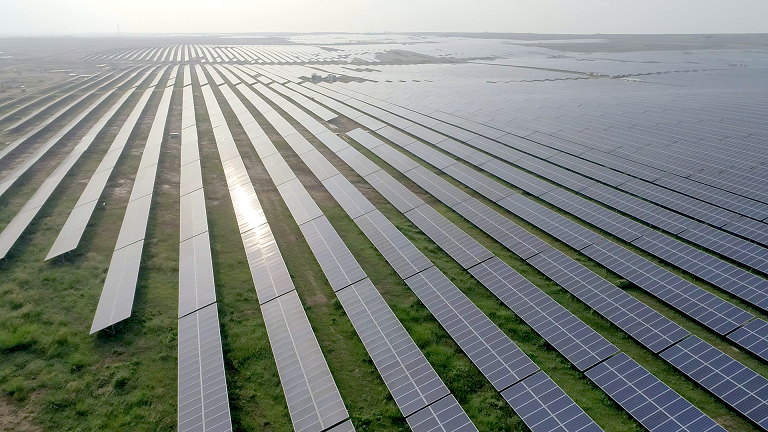As of August 2025, India’s solar capacity had surged to 123.13 GW, a testament to the country’s growth story in clean energy. In just the first half of 2025, India added 18 GW to this capacity, marking a 31% rise over last year’s figure. Yet, persistent bottlenecks in the construction and execution of solar projects threaten this growth. These bottlenecks particularly affect large-scale solar projects, which account for 86% of India’s solar capacity. With over 50 GW of renewable capacity stranded nationwide as of June 2025, the message is clear: identifying and overcoming the challenges in India’s construction sector is no longer optional but essential to sustain the country’s solar growth.
Land uncertainty
This is one of the most common and unpredictable bottlenecks. Data on land classification, whether forest, agricultural, or government-owned, are not consolidated on a single portal, and land boundaries are often poorly marked. Developers sometimes begin early works, only to discover later that the areas fall under restricted categories. This forces a redesign of the project, delays clearances, and even shrinks the usable project area. A recent example is the Jaisalmer Oran land dispute, where the Rajasthan High Court halted the allocation of sacred community lands for a 12.5 GW solar park. Though recorded as government property, these Orans are considered sacred by the local community, and the court’s stay highlights how unclear land records can derail even flagship solar projects.
Inadequate early-stage design finalisation
Developers, under pressure to show visible progress, often start site preparation and procurement before structural and electrical designs are approved. This leads to rework, material wastage, and cost overruns once detailed engineering and design studies reveal inconsistencies. In overseas markets such as Europe and the United States, frameworks require significant design approval before construction begins, ensuring smoother execution and fewer downstream risks.
Weak project management and coordination
Execution of large solar plants in India is often slowed by fragmented project management. Civil works, electrical systems, and transmission are usually handled by separate contractors with little coordination. Without a centralised framework, decision-making lags, contractor interfaces are poorly managed, and workstreams overlap. A common case is when plants are mechanically complete but transmission lines are not ready, leaving capacity idle. For instance, over 8 GW of completed renewable energy projects remain stranded in Rajasthan due to delays in transmission system strengthening, leaving fully built plants unable to evacuate power.
By contrast, global markets emphasise integrated project management and clear accountability across the supply chain, enabling tighter schedules, higher productivity, and smoother commissioning.
Unskilled manpower and safety risks
India’s reliance on untrained labour increases inefficiency and risk. Project sites are often overstaffed, yet productivity remains low due to poor skills and workmanship. The absence of structured training also poses safety risks, as unqualified workers handle electrical systems and heavy machinery, leading to accidents.
In contrast, solar projects abroad employ workforces holding certifications such as NEBOSH (National Examination Board in Occupational Safety and Health) and OSHA (Occupational Safety and Health Administration). This ensures consistent quality and stronger safety performance.
Regulatory challenges
Regulatory approvals in India remain among the most complex hurdles for Indian developers. Projects must navigate multiple permissions from both central and state authorities. Each authority follows its own procedures and timelines, with little coordination among them. Developers often lack visibility into application backlogs or expected timelines. In some cases, approvals are expedited through informal influence, adding both uncertainty and inequity.
To add to these challenges, weather cycles and extreme events pose risks to India’s utility-scale solar construction. Heavy rainfall can flood sites, wash away internal roads, and delay civil works such as cable trenching. Often, work halts for weeks because machinery cannot operate on waterlogged soil. For instance, Tata Power Renewable Energy’s 0.3 GW project in Gujarat saw 33 kV cable trenches submerged by unexpected rainfall, forcing a redesign of the cabling.
The Road Ahead
Embracing global best practices and strengthening domestic systems will unlock faster, safer, and more efficient utility-scale solar construction. Practices such as no construction at the conceptual stage and only carrying out enabling works such as fencing, grading, and approach road construction in the feasibility stage will help. Full-scale construction should begin only after good-for-construction (GFC) drawings are issued.
Further, EPC project management must be modernised through digital tools, stronger coordination, and workforce training. Grid infrastructure must expand in sync with renewable capacity. Above all, closer collaboration between utilities, developers, and regulators is vital to minimise delays in approvals and power purchase agreements. A disciplined approach at the construction stage will also translate into lower operation and maintenance costs and more stable generation over 25 years—the lifespan of a solar power plant.
Sheikh Madiha Syed is an Analyst in the Renewables group at the Center for Study of Science, Technology and Policy (CSTEP), a research-based think tank. Shashikant Yadav is Manager-Engineering Services at Blueleaf Energy.
The views and opinions expressed in this article are the author’s own, and do not necessarily reflect those held by pv magazine.
This content is protected by copyright and may not be reused. If you want to cooperate with us and would like to reuse some of our content, please contact: editors@pv-magazine.com.








2 comments
By submitting this form you agree to pv magazine using your data for the purposes of publishing your comment.
Your personal data will only be disclosed or otherwise transmitted to third parties for the purposes of spam filtering or if this is necessary for technical maintenance of the website. Any other transfer to third parties will not take place unless this is justified on the basis of applicable data protection regulations or if pv magazine is legally obliged to do so.
You may revoke this consent at any time with effect for the future, in which case your personal data will be deleted immediately. Otherwise, your data will be deleted if pv magazine has processed your request or the purpose of data storage is fulfilled.
Further information on data privacy can be found in our Data Protection Policy.